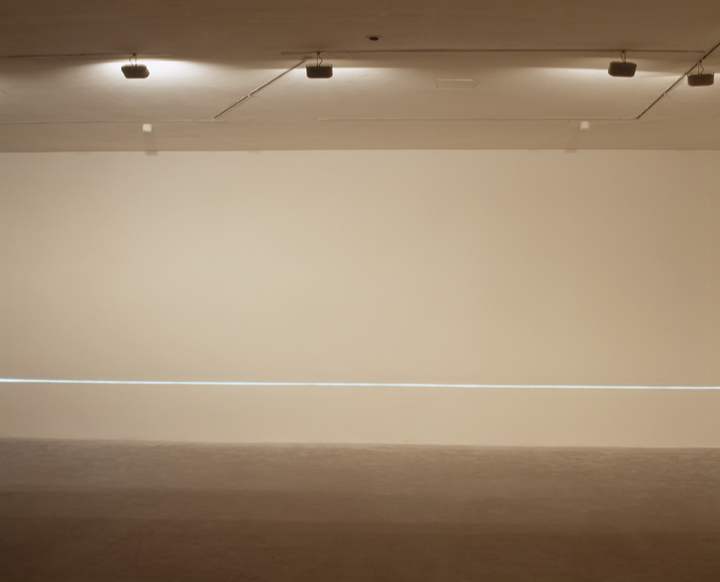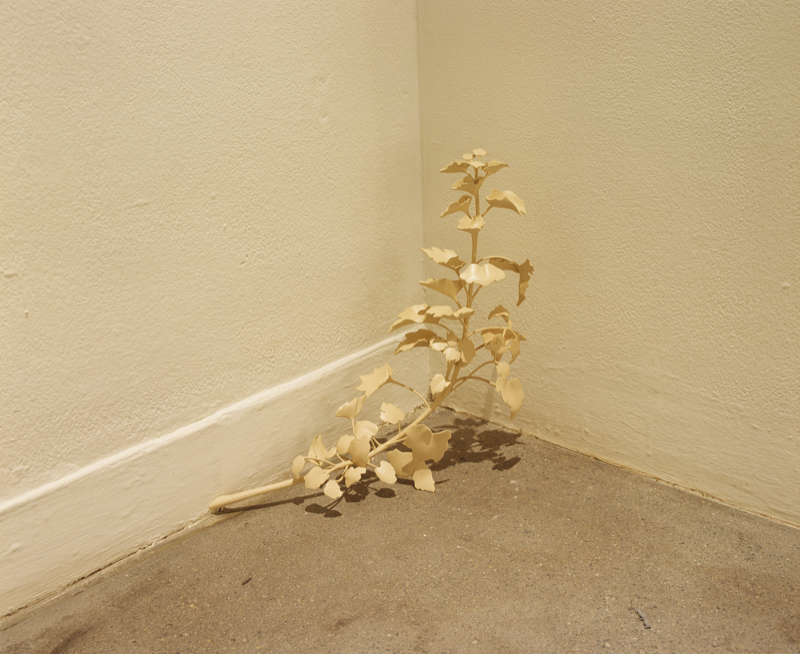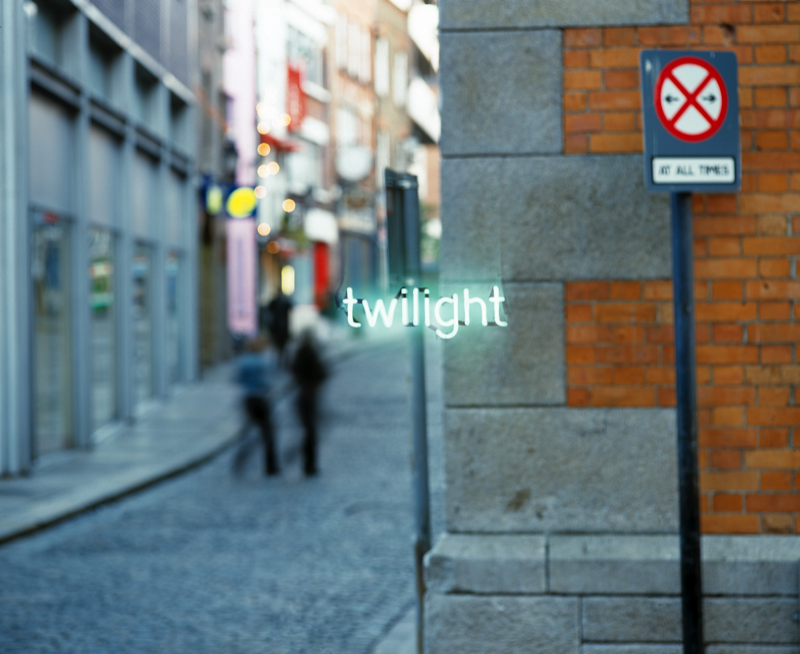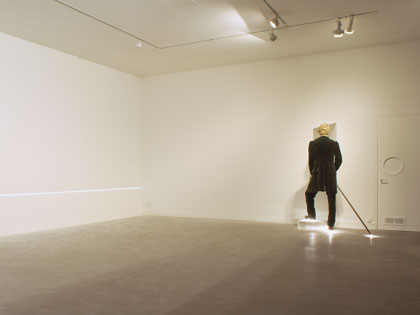

The exhibition consists of a number of works which address the periphery of the gallery or extend through the gaze of a figurative sculpture or a reflection on a window, beyond the very boundaries of the walls themselves. On entering the gallery, the first work seen is a white neon of the word ‘Twilight’ which is written in reverse."‘Twilight’, a neon text written backwards, can be read correctly only in the reflection on the glass of the gallery's window.
Like an eclipse of the sun, the piece is best seen by looking away from it. This ‘looking away’ introduces a trace of enigma, figuring an intimate bond between the viewer and the artwork through a lack or drift. It addresses the viewer via the distance between the object and the edge of the room. Something is extracted from the object and something returned to it. The object is reproduced – must be reproduced for its own legibility – in reflection and thereby surrenders some part of its aura as a unique object. In effect, the work is neither sculpture nor print but a hybrid form that uses architecture as a screen for an object that it houses. In exchange for this loss of aura, the object regains its alterity, no longer existing merely as the object of attention, as spectacle. It is an object that is needful and dependent, not cut off from everything according to the model of modernist autonomy. ‘Looking away’ is a kind of twilight vision, a form of vision on the verge of not looking, a half-look that preserves the viewer from the tyranny of the eye. This gesture is reminiscent of Caspar David Friedrich’s instruction that before you start a painting you should close your eyes, which supplements (and overwhelms) the visual with the imaginative and spiritual...
At the opposite side of the gallery, facing into a small internal window between the gallery and the hallway,a life-size figurative sculpture ‘The Wanderer’ stares mutely out.
"Walker and Walker’s ‘The Wanderer’, a fibreglass life-size figure dressed in a velvet replica of a nineteenth-century suit, (which) is based on Friedrich’s painting ‘The Wanderer Above the Sea of Fog’. In Friedrich’s painting the solitary figure stands before sublime nature and above not only the sea of fog, but the rest of humanity. None of Zarathustra’s contempt or Sardanapalus’ disregard for the life of others is evident in the painting, but the wanderer is elevated, heroic, separated from the social body, a man apart. His outfit already fixes him as otherly, existing outside the norm. In Walker and Walker’s replica, the elevation of the wanderer is a miniature of the mountainous heights of the original, and yet more miraculous still: the figure levitates 5cm above the ground. Here is the separation of the Romantic sensibility – palpably, visibly evident.
And to underline the separation from the earth as a charged, preternatural distinction, Walker and Walker have the wanderer floating on a pillow of light. White halogen light: this is a futuristic echo of the Romantic original. Inactivity, uninterrupted and timeless engrossment, silence and separation add up to an effect of Romantic otherworldliness. This is an otherworldliness, as we have seen, that may, ultimately, be a technique for securing a place for the artist within the social body – or a social body other than the social body prepared for it by Classicist precedent. ‘The Wanderer’ favours this reading in the way it transposes the aspirations that formed the original image: instead of the natural, awe inspiring depths of mountainous terrain, Walker and Walker’s wanderer is transfixed by what lies beyond the gallery. For Friedrich, the wanderer is seen only from behind, turning his back on the world of the spectator to be fully engrossed by the world of sublime nature or to look inward into the sublime depths of his imagination; Walker and Walker’s sculpture turns its back on the gallery, looking for a world beyond it..." David Beech

The horizon was extremely important to the Romantics, for them it signified a site of new possibilities. Romanticism ushered in a new conception of the artist as self-fashioning, self-determined and independent. Being thus liberated from history, tradition, convention and social mores, Romantic artists set out to establish their own horizons rather than be commanded by inherited limits.
"'Horizon’, a luminous horizontal line emanating from the interior of the gallery wall, reduces the features of the landscape further still. Fascination and reverie are signified in its glow, its immaterial emergence and abstraction from the landscape of which it is a tiny albeit ideal fragment. Pictorially, ‘Horizon’ is starkly minimal; geometrically, the only mark that could be reduced further than the simple straight line." David Beech
"'Horizon’, a luminous horizontal line emanating from the interior of the gallery wall, reduces the features of the landscape further still. Fascination and reverie are signified in its glow, its immaterial emergence and abstraction from the landscape of which it is a tiny albeit ideal fragment. Pictorially, ‘Horizon’ is starkly minimal; geometrically, the only mark that could be reduced further than the simple straight line." David Beech

A final sculpture titled Drawing, Nature Study is a 3D rendered sculpture of a little known drawing ‘Nature Study’ by Casper David Friedrich. The sculpture which is made from carved resin is placed in the vicinity of a corner and has the appearance of a weed growing out at the base of the wall.

